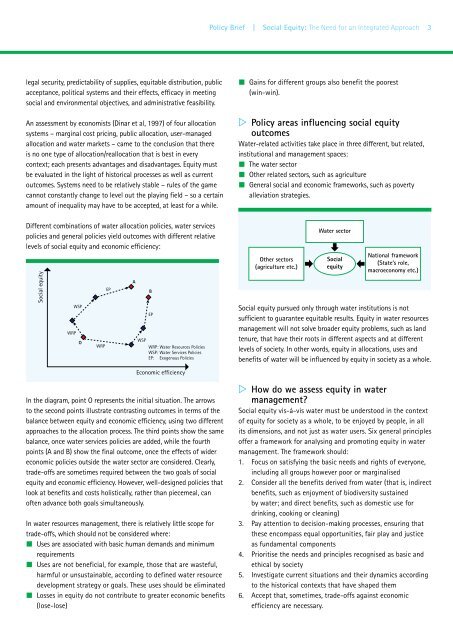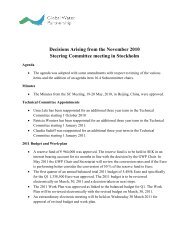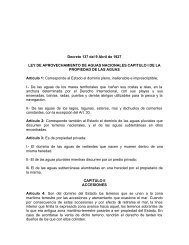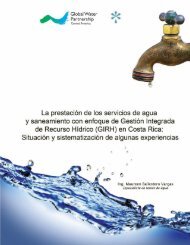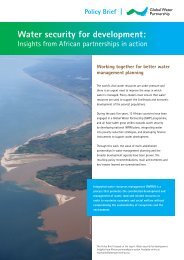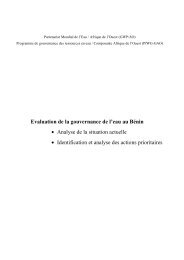Policy Brief | Social Equity - Global Water Partnership
Policy Brief | Social Equity - Global Water Partnership
Policy Brief | Social Equity - Global Water Partnership
Create successful ePaper yourself
Turn your PDF publications into a flip-book with our unique Google optimized e-Paper software.
<strong>Policy</strong> <strong>Brief</strong> | <strong>Social</strong> <strong>Equity</strong>: The Need for an Integrated Approach 3legal security, predictability of supplies, equitable distribution, publicacceptance, political systems and their effects, efficacy in meetingsocial and environmental objectives, and administrative feasibility.An assessment by economists (Dinar et al, 1997) of four allocationsystems – marginal cost pricing, public allocation, user-managedallocation and water markets – came to the conclusion that thereis no one type of allocation/reallocation that is best in everycontext; each presents advantages and disadvantages. <strong>Equity</strong> mustbe evaluated in the light of historical processes as well as currentoutcomes. Systems need to be relatively stable – rules of the gamecannot constantly change to level out the playing field – so a certainamount of inequality may have to be accepted, at least for a while.Different combinations of water allocation policies, water servicespolicies and general policies yield outcomes with different relativelevels of social equity and economic efficiency:<strong>Social</strong> equityWRPWSPOWRPEPABEPWSPWRP: <strong>Water</strong> Resources PoliciesWSP: <strong>Water</strong> Services PoliciesEP: Exogenous PoliciesEconomic efficiencyIn the diagram, point O represents the initial situation. The arrowsto the second points illustrate contrasting outcomes in terms of thebalance between equity and economic efficiency, using two differentapproaches to the allocation process. The third points show the samebalance, once water services policies are added, while the fourthpoints (A and B) show the final outcome, once the effects of widereconomic policies outside the water sector are considered. Clearly,trade-offs are sometimes required between the two goals of socialequity and economic efficiency. However, well-designed policies thatlook at benefits and costs holistically, rather than piecemeal, canoften advance both goals simultaneously.In water resources management, there is relatively little scope fortrade-offs, which should not be considered where:• Uses are associated with basic human demands and minimumrequirements• Uses are not beneficial, for example, those that are wasteful,harmful or unsustainable, according to defined water resourcedevelopment strategy or goals. These uses should be eliminated• Losses in equity do not contribute to greater economic benefits(lose-lose)• Gains for different groups also benefit the poorest(win-win). <strong>Policy</strong> areas influencing social equityoutcomes<strong>Water</strong>-related activities take place in three different, but related,institutional and management spaces:• The water sector• Other related sectors, such as agriculture• General social and economic frameworks, such as povertyalleviation strategies.Other sectors(agriculture etc.)<strong>Water</strong> sector<strong>Social</strong>equityNational framework(State’s role,macroeconomy etc.)<strong>Social</strong> equity pursued only through water institutions is notsufficient to guarantee equitable results. <strong>Equity</strong> in water resourcesmanagement will not solve broader equity problems, such as landtenure, that have their roots in different aspects and at differentlevels of society. In other words, equity in allocations, uses andbenefits of water will be influenced by equity in society as a whole. How do we assess equity in watermanagement?<strong>Social</strong> equity vis-á-vis water must be understood in the contextof equity for society as a whole, to be enjoyed by people, in allits dimensions, and not just as water users. Six general principlesoffer a framework for analysing and promoting equity in watermanagement. The framework should:1. Focus on satisfying the basic needs and rights of everyone,including all groups however poor or marginalised2. Consider all the benefits derived from water (that is, indirectbenefits, such as enjoyment of biodiversity sustainedby water; and direct benefits, such as domestic use fordrinking, cooking or cleaning)3. Pay attention to decision-making processes, ensuring thatthese encompass equal opportunities, fair play and justiceas fundamental components4. Prioritise the needs and principles recognised as basic andethical by society5. Investigate current situations and their dynamics accordingto the historical contexts that have shaped them6. Accept that, sometimes, trade-offs against economicefficiency are necessary.


